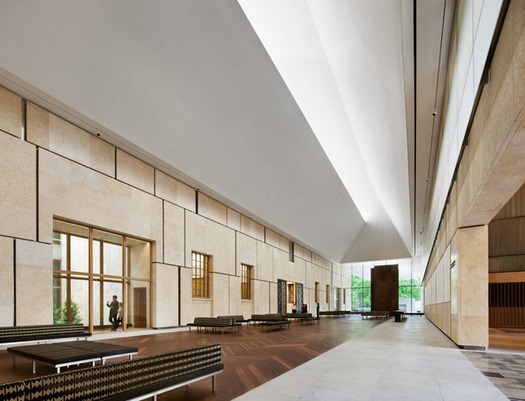
July 26, 2012
The Barnes Foundation and Corporate Space

Anenberg Court. Photo by Michael Moran
Back in 1923, while his gallery in suburban Merion was still a work in progress, Albert Barnes wrote to his architect, Paul Cret, suggesting that he booby trap the place against the “eunuchs, morons, boobs, professional exploiters, general counterfeits” and various other Philadelphia “prominentists” who had rejected him and his art collection. Cret didn’t put in Barnes’s secret trap to an underground dungeon, but it wasn’t necessary; Barnes famously managed to keep Philadelphia’s brahmins (and much of the public) out by legal means for a very long time indeed. This is not news.
I don’t count myself among those who were inherently opposed to the move of the Barnes to a new museum in downtown Philadelphia. Nevertheless, I was left with mixed feelings about the place, a beautifully composed stack of blocks designed by Tod Williams and Billie Tsien, which places a simulacrum of the old Barnes adjacent to a large atrium. As I write in a review of the building in the AR:
For all the good-faith efforts of the architects, much of the work is not shown to its best advantage. You are forced, at the Barnes, to see Albert Barnes’ collection as Albert Barnes wanted you to see it, even now, long after his death. Was some kind of compromise solution here not possible? The difficulties of the situation are perhaps best illustrated by the state of a gallery that holds a large number of works on paper by Matisse, but also two extraordinary paintings by the master. The light in the room is kept low to conserve the more fragile works, which means the two oils are forever consigned to be seen at a disadvantage. In any other circumstance, a rational curator would simply move the two oil paintings to another space.
I found myself contemplating this while seated in the Annenberg Court, a space that encapsulates all the contradictions of the museum. What, precisely, is this giant open room for? Its enormous volume stands in contrast to the more domestic interiors of the galleries proper, and there is no sculpture that might give it a human scale. People mill about, but they could just as easily do that elsewhere. It is, inescapably, an ‘event space’, a room for corporate functions, as the cattle call of sponsors hailed to the podium at the opening ceremony made plain. There is something inherently disturbing about making this the very heart of the museum, and not simply because, more than any of the other breaks with the Barnes trust, it is so blatantly opposed to his original intent. I could not help but think of the recent museum erected in Denver for the work of Clyfford Still, another American crank with demands about how his work be presented. There are no grand courts. There’s no café either (the Barnes has two), not even a gift shop. There’s nothing but art.
The ever-increasing corporatization of public space is one of the critical issues facing architecture today, and is of course a reflection of a very sad moment in our culture, when a candidate for president can state that corporations are people, and see this idea given legal form by the Supreme Court. But more on this later.
Observed
View all
Observed
By Mark Lamster
Related Posts

The Observatory Newsletter
Delaney Rebernik|Analysis
A story of bad experiential design

The Observatory Newsletter
Ellen McGirt|Essays
Lessons in wandering

Architecture
Sameedha Mahajan|Design and Climate Change
The airport as borderland: gateways for some, barriers for others

The Observatory Newsletter
Alexis Haut|Analysis
“Pay us what you owe us”
Related Posts

The Observatory Newsletter
Delaney Rebernik|Analysis
A story of bad experiential design

The Observatory Newsletter
Ellen McGirt|Essays
Lessons in wandering

Architecture
Sameedha Mahajan|Design and Climate Change
The airport as borderland: gateways for some, barriers for others

The Observatory Newsletter
Alexis Haut|Analysis
